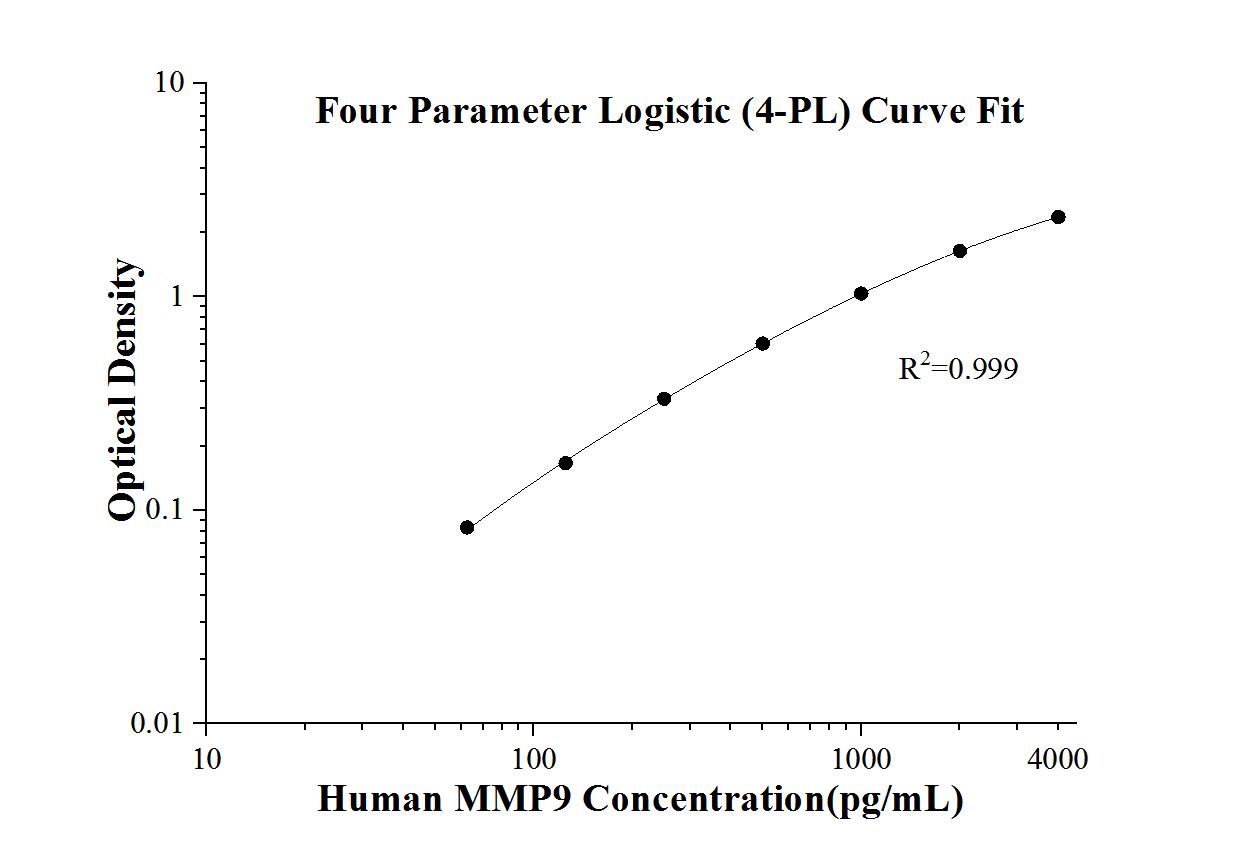Human MMP-9 ELISA Kit
Cat no : KE00164
Synonyms
MMP9, 67 kDa matrix metalloproteinase-9, 82 kDa matrix metalloproteinase-9, CLG4B, EC:3.4.24.35
Validation Data Gallery
Product Information
KE00164 is a solid phase sandwich Enzyme Linked-Immuno-Sorbent Assay (Sandwich ELISA). The MMP9 ELISA kit is to be used to detect and quantify protein levels of endogenous MMP9. The assay recognizes human MMP9. An antibody specific for MMP9 has been pre-coated onto the microwells. The MMP9 protein in samples is captured by the coated antibody after incubation. Following extensive washing, another antibody of biotinylated specific for human MMP9 is added to detect the captured human MMP9 protein. For signal development, Streptavidin-HRP is added, followed by Tetramethyl-benzidine (TMB) reagent. Solution containing sulfuric acid is used to stop color development and the color intensity which is proportional to the quantity of bound protein is measurable at 450 nm with the correction wavelength set at 630 nm.
| Product name | Human MMP-9 ELISA Kit |
| Tests | 1 X 96 well plate |
| Sample type | Serum, Plasma, Cell culture supernatants, Saliva |
| Assay type | Sandwich |
| Sensitivity | 10.0 pg/mL |
| Range | 62.5-4000 pg/mL |
| Reactivity | Human |
| Tested applications | Sandwich ELISA |
| Gene ID (NCBI) | 4318 |
Recovery
| Sample Type | Average | Range |
|---|---|---|
| Human Serum | 100% | 96%-105% |
| Cell culture supernatants | 96% | 85%-104% |
| Saliva | 99% | 92%-107% |
IntraAssay
| Sample | n | mean ( pg/mL) | SD | CV% |
|---|---|---|---|---|
| 1 | 20 | 1,654.2 | 25.5 | 1.5 |
| 2 | 20 | 399.5 | 11.8 | 3.0 |
| 3 | 20 | 93.2 | 2.3 | 2.5 |
InterAssay
| Sample | n | mean ( pg/mL) | SD | CV% |
|---|---|---|---|---|
| 1 | 24 | 1,631.7 | 52.0 | 3.2 |
| 2 | 24 | 413.2 | 14.2 | 3.4 |
| 3 | 24 | 93.9 | 6.3 | 6.7 |
Background Information
MMP9 (matrix metallopeptidase 9), also named as Gelatinase B, is a member of matrix metalloproteinase (MMP) family. The MMP family of enzymes is comprised of critically important extracellular matrix remodeling proteases whose activity has been implicated in normal embryogenesis, tissue remodelling and many diseases such as arthritis, cancer, periodontitis, glomerulonephritis, encephalomyelitis, atherosclerosis and tissue ulceration. These proteases have come to represent important therapeutic and diagnostic targets for the treatment and detection of human cancers. MMP9 is produced by a variety of normal and transformed cells including neutrophils, monocytes, macrophages, astrocytes, fbroblasts, osteoclasts and so on. In tumors, MMP-9 destroys collagen (type IV) in the vascular basal membrane in the vicinity of tumor cells which invade the surrounding tissues and contributes to metastasis. Circulating levels of MMP-9 are increased in many inflammatory disorders such as atherosclerosis, hepatitis C virus infection and colorectal cancer.
Properties
| Storage Instructions | All the reagents are stored at 2-8℃ for 6 months or -20℃ for 12 months. Refer to the protocol for further storage instructions. |
| Synonyms | MMP9, 67 kDa matrix metalloproteinase-9, 82 kDa matrix metalloproteinase-9, CLG4B, EC:3.4.24.35 |
Publications
| Species | Sample Type | Title |
|---|---|---|
Front Cell Dev Biol miR-7-5p Affects Brain Edema After Intracerebral Hemorrhage and Its Possible Mechanism. | ||
Biomedicines Prolonged Cardiopulmonary Bypass Time-Induced Endothelial Dysfunction via Glypican-1 Shedding, Inflammation, and Matrix Metalloproteinase 9 in Patients Undergoing Cardiac Surgery | ||
J Clin Med Zinc Administration and Improved Serum Markers of Hepatic Fibrosis in Patients with Autoimmune Hepatitis. | ||
Exp Mol Pathol Phorbol 12-myristate 13-acetate stimulation under hypoxia induces nuclear swelling with DNA outflow but not extracellular trap formation of neutrophils. | ||
Front Immunol Interleukin-26–DNA complexes promote inflammation and dermal-epidermal separation in a modified human cryosection model of bullous pemphigoid | ||
Adv Sci (Weinh) ETV4 Mediated Tumor-Associated Neutrophil Infiltration Facilitates Lymphangiogenesis and Lymphatic Metastasis of Bladder Cancer |
